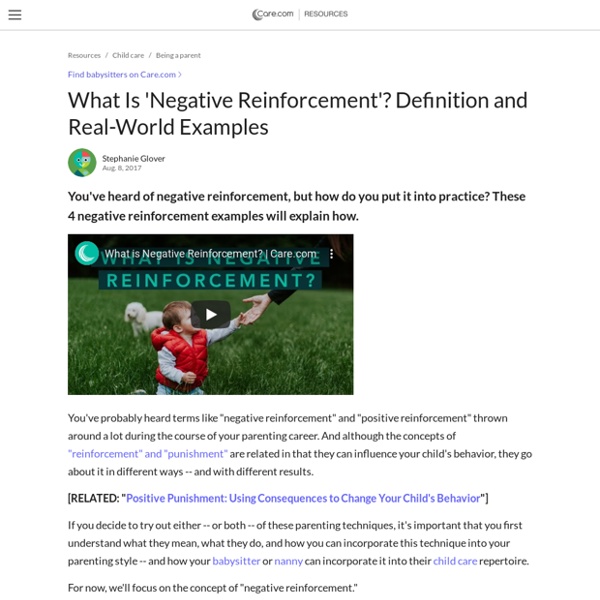What Is 'negative Reinforcement'? Definition And Real-World Examples

https://www.care.com/c/stories/3466/what-is-negative-reinforcement-definition-and-real-world-examples/
Related: Parents' Guide to Influence Teenager's Behaviour - Reinforcement & Punishment
• Reinforcement vs Punishment: Disciplining teenage children
• parminder_kaur
• Understand Reinforcement and Punishment in Parenting Teenagers
• phgoh003
Positive vs Negative Reinforcement: Which Is More Effective?
The central premise of Pavlok is getting the user to take action and create a new habit — or change an existing one. To do this, we built “pattern interrupts” — jarring but effective stimuli — into the device that encouraged users to change their routines. We then faced a difficult question that’s challenged behavioral psychologists for decades. Which is more effective for behavior change: Negative or positive reinforcement? Positive reinforcement is a reward for doing something well.
What Are the Benefits of Positive Reinforcement in Kids?
Reinforcing good behavior while discouraging disobedience and anti-social behavior generally produces positive results in children. Positive reinforcement helps children feel good about their choices, which motivates them to increase the behaviors that bring rewards. Praise and positive reinforcement usually produces both short-term and long-term benefits as children learn helpful habits that will prove beneficial throughout life. Discipline involves teaching and instructing children. While some people use punitive measures or the removal of privileges, positive reinforcement might have fewer long-term consequences and more life-long benefits. In a study published in the 2001 “Journal of Applied Behavior Analysis,” Samantha, a 10-year-old autistic child, consistently chose positive reinforcement when asked to perform certain tasks.
Positive Punishment: What It Is, Benefits, and Examples
Positive punishment is a form of behavior modification. In this case, the word “positive” doesn’t refer to something pleasant. Positive punishment is adding something to the mix that will result in an unpleasant consequence. The goal is to decrease the likelihood that the unwanted behavior will happen again in the future.
How to Reward Your Teen for Good Behavior
Teenagers are young adults who are trying to learn the ways of the world. When they do something great at school or at home or simply make a healthy decision, parents can give them a reward. The reward does not have to be money, but it is a nice way to say "thank you" or "I'm proud of you."
Punishing a Child Is Effective If Done Correctly
TORONTO — While recently published parenting books have preached the effectiveness of positive parenting and “no drama” discipline, psychologists presenting at the American Psychological Association’s 123rd Annual Convention said don’t put timeout in timeout yet. “Parental discipline and positive parenting techniques are often polarized in popular parenting resources and in parenting research conclusions,” presenter and researcher Robert Larzelere, PhD, of Oklahoma State University, said at a symposium. “But scientifically supported parenting interventions for young defiant children have found that timeouts and other types of assertive tactics can work if they’re administered correctly.”
Negative Reinforcement and Operant Conditioning
Negative reinforcement is a term described by B. F. Skinner in his theory of operant conditioning. In negative reinforcement, a response or behavior is strengthened by stopping, removing, or avoiding a negative outcome or aversive stimulus.1 Overview
Tips on the Misuses of Negative Reinforcement for Parents
So often, parents become frustrated with their little ones as the twists and turns of toddler logic throw adults for a loop. The "because I said so" that seemed so unfair to us just years ago is now the only response that doesn't start a bartering session. Some parents reach for negative reinforcement, when positive reinforcement doesn't seem to be enough. Negative reinforcement is when a parent rewards a child for good behavior by taking away an aversion in his daily life. For instance, if a preschooler picks up all the cereal he spilled on the floor, she doesn't have to help mom clean the bathroom.
Positive Punishment: What Is It And How It Works? - MomJunction
Positive punishment! Sounds like a perfect oxymoron. But how can a punishment be positive? How can you even enforce such a punishment? Is it effective?
6 Positive Reinforcement Examples To Try With Your Kids ...
Positive reinforcement — using praise or rewards to shape your child's behavior — means "focusing on the 'good' things your children are doing or certain behaviors that you like and that you want to see more of," explains Melanie Rudnick, a New York City-based parenting expert and conscious parenting coach. As these positive reinforcement examples will show, and as Dr. Nadja Reilly, a clinical psychologist and the associate director of the Freedman Center for Child and Family Development, explains, it can also be a great tool for communicating to your child the actions or values that you feel are important. Here are some easy examples of how you can use positive reinforcement at home to shape your child's behavior. 1. You're working hard putting away toys!
Related:
Reinforcement and punishment: A Guide for Parents of teenagers
•
Reinforcement or punishment? Raising your child correctly - A resource centre for all parents
•
Parenting Teens: Reinforcement and Punishment and Other Parenting Tips
•
An Introduction to what reinforcement and punishment are to parents in disciplining their children
•
Reinforcement and Punishment to Influence the Behaviour of Teenager
•
Reinforcements
•
Influencing Teenagers




Negative reinforcement can be used as a parenting technique to encourage good behavior in teenagers by removing an unfavorable stimulus in their lives. A classic example is for parents to nag appropriately and proportionately at their teenage child when they refuse to do their homework. The nagging are likely to negatively reinforce the child's behavior of doing homework so that the negative stimulus of the parents' nagging can be removed. by jonquah Sep 25